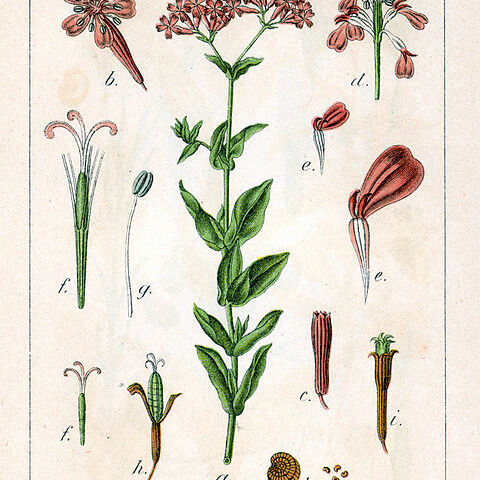Taprooted annual or biennial. Stems 1-several, erect, glabrous, usually with a dark sticky patch c. 1 cm long beneath upper nodes, (10)-20-50 cm tall. Lvs glabrous, glaucous; basal lvs obovate to oblanceolate to spathulate, subacute to acute, cuneate at base, 3-6 × 0.5-1.5 cm; stem lvs ovate to lanceolate, sessile and amplexicaul at base, acute, (1.5)-2-7-(10) × (0.5)-1-2-(2.5) cm. Infl. a 10-30-flowered sub-capitate dichasium; pedicels 2-5-(9) mm long; bracts ovate, scarious. Fls ☿. Calyx glabrous, narrowly cylindric, broadest above middle, not or slightly contracted at mouth, 10-veined, often pinkish, 12-15 mm long; teeth oblong, obtuse, erect. Petals pink; limb obtuse to shallowly emarginate; claw not lobed; coronal scales linear-acuminate, c. 2 mm long. Styles 3, erect, c. 5 mm long. Capsule oblong, included in calyx, 5-7 mm long; teeth 6; carpophore c. 6 mm long. Seeds red-brown, reniform, finely warty, 0.6 mm long; faces hollowed; back grooved.
Glabrous or rarely sparsely puberulent annual 1–7 dm, the stem sometimes with slightly glutinous zones below some of the upper nodes; lvs sessile and ± clasping (basal more spatulate), 2–5 × 0.5–1.5 cm, rather numerous; infl open or compact, the ultimate cymes congested; cal tubular-clavate, much constricted below, umbilicate, 13–17 mm, 10-nerved; pet pink or lavender, auricles none, appendages linear, 2–3 mm, the blade 4–7 mm, obovate, truncate to emarginate; carpophore 7–8 mm; fr almost wholly 3-locular; seeds 0.6 mm wide, rugose; 2n=24. Native of Europe, formerly much cult., and found as a casual weed in our range. June, July.
Polymorphous, annual or biennial, glaucous herb. Stems erect, up to 40 cm, viscid in upper part. Leaves spathulate in basal part, early withering; cauline leaves ovate-cordate to narrowly elliptic with acute apex. Inflorescence usually rather densely flowered, but often with two main branches. Calyx cylindrical, widened towards apex, 10-13 mm, teeth obtuse to acute. Petals usually pink, lamina obovate, emarginate, coronal scales narrowly elliptic, acute. Ovary ovoid. Capsule oblong, 7-10 mm, as long as or slightly longer than the carpophore. Seeds dark brown, reniform, rugose, c. 0.8 mm.
Pending.

